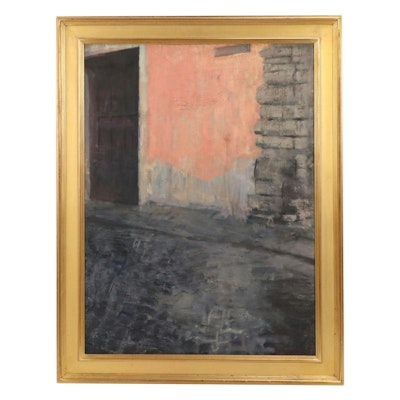From the 1950s until the late 1970s, the Pop Art movement dominated the modern art scene. What began as a rebellion against Abstract Expressionists quickly became a big, bold statement about commercialism and modernity. This movement certainly made a splash on the art world. It also greatly influenced the design world, and continues to permeate the art world with many contemporary artists embracing the Pop style. Join EBTH on a journey through the evolution of Pop Art.
The Pop Art movement began in the later 1950s in London as groups of artists formed the Independent Group, which included members such as Richard Hamilton, Eduardo Paolozzi, and architects Peter and Alison Smithson. A few short years later, the movement spread to America. To understand how the movement was born, consider the times. The Pop Art movement began during the cultural revolution of the mid-20th century. Following the post-World War II boom of economic and political growth, activists, thought leaders, and artists began breaking the boundaries of conformity to redefine everything from civil rights and women’s liberation to mass media and art itself.
Artists in this new generation drew inspiration from the everyday world around them. Bold colors, commercial methods like silk-screening, and mundane, realistic imagery became synonymous with the movement, which transcended any singular artistic form to include sculptures, prints, paintings, and photography. The artists in this movement melded fine art with popular culture. They added bold primary colors, elements from ads and other mass media, realism, and a heavy dose of wit and irony to make big, bold statements.
Unlike movements in which the work is highly personal, Pop Art features an emotional distance between the artist and the subject. Experts often describe the work as ambivalent, which may in fact be a statement by the artists about the acceptance of the new popular world around them.
The ideas and inspiration of the artists, combined with the bold styles they employed, really defined the Pop Art movement and differentiated it from others before and after. A few of the main concepts include:
1. The blurred boundaries between fine art and low culture that obliterated the hierarchy, preventing one from borrowing from the other.
2. While Expressionists delved into the trauma of the soul, Pop artists dealt with the trauma of the modern world and the interconnection of everything, including the soul, natural world, and constructed modern environment.
3. Critics often note the movement’s seeming endorsement of capitalism and mass-produced goods, while fans note elements of cultural critique.
4. Many works removed inspiring material from its original context and combined it with other objects or isolated it entirely to transform the subject.
5. Many of the key artists in the movement spent their early careers producing commercial art, which influenced their visual mastery of mass culture.
From the late 1950s through the 1960s and beyond, some of the leading artists of the time embraced this visual art movement. Known for their brash style and bold colors, the following artists were among some of the most influential figures that shaped Pop Art.
Roy Lichtenstein was one of the earliest icons of the Pop Art movement during the 1960s. During that time, Lichtenstein taught at Rutgers University, and his work became a commentary on popular culture. The artist quickly garnered attention for his vibrantly colored, highly stylized work. He derived inspiration from comic books and advertising. Some of his works include:
“Whaam!”
“Drowning Girl”
“I Love Liberty”
“Reflections on Crash”
This Swedish-born American sculptor is one of the artists credited with bringing Pop Art to the public. Claes Oldenburg gained fame after moving to New York in the mid-1950s. His early work included paintings and magazine illustrations, but he became best known for his sculptures, including:
“Pastry Case”
“Soft Toilet”
“Lipstick Ascending on Caterpillar Tracks”
“Clothespin”
David Hockney brought his unmistakable style to the British Pop Art movement in the 1960s. He integrated styles such as Baroque and Cubism with color theory and deconstructed proportions while focusing on personal subject matter, which set him apart from many of his contemporaries. Some of his well-known works include:
“A Bigger Splash”
“We Two Boys Together Clinging”
“American Collectors”
“A Visit with Christopher and Don, Santa Monica Canyon”
“A Bigger Grand Canyon”
No mention of famed Pop artists would be complete without a brief discussion of Andy Warhol. After all, when most people think about this movement, they immediately think of Warhol. He explored a variety of media, including painting, filmmaking, and performance art. His combination of commercial, mainstream aesthetics and fine art led him to become one of the leading figures of the Pop Art movement. A few of his famous pieces include:
“Campbell’s Soup Cans”
“Coca-Cola”
“Gold Marilyn Monroe”
“Self-Portrait”
“The Last Supper”
Keith Haring is a Pennsylvania-born artist who achieved international fame between 1980 and 1989 with his graffiti-inspired artwork, which debuted in subway stations and later featured in museum exhibits. Some of his notable works include numerous unnamed Pop Shop silkscreens, a mural on the Berlin Wall, his “Crack is Whack” mural in Harlem, New York, and paintings such as:
“Andy Mouse”
“A Pile of Crowns for Jean-Michel Basquiat”
“Free South Africa”
“Rebel with Many Causes”
Now that you’re more familiar with the Pop Art movement, browse our online art auctions to find an amazing piece of art for your collection. Discover incredible art pieces every day from around the world and across history.





















There are some amazing, one-of-a-kind items waiting to be discovered. Sign in to start bidding!
Not a member? Sign up.